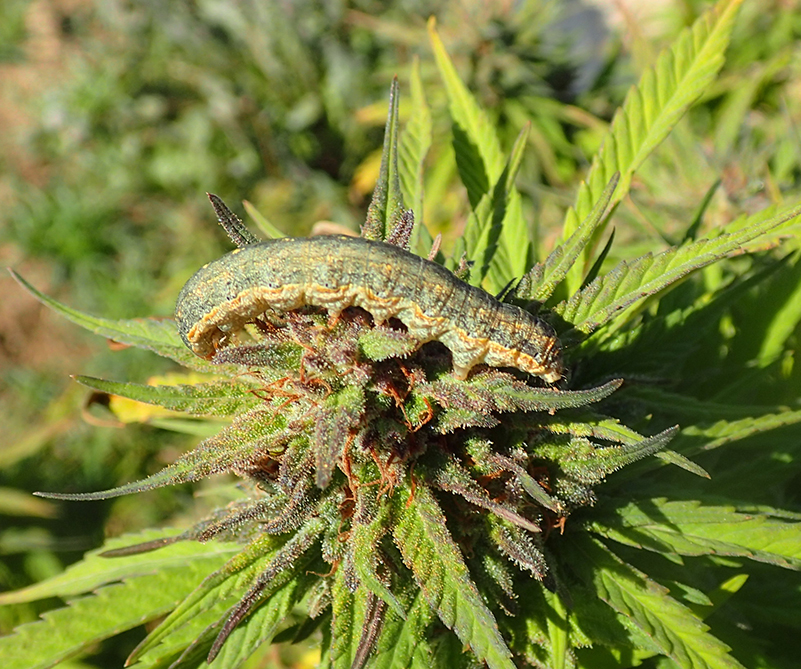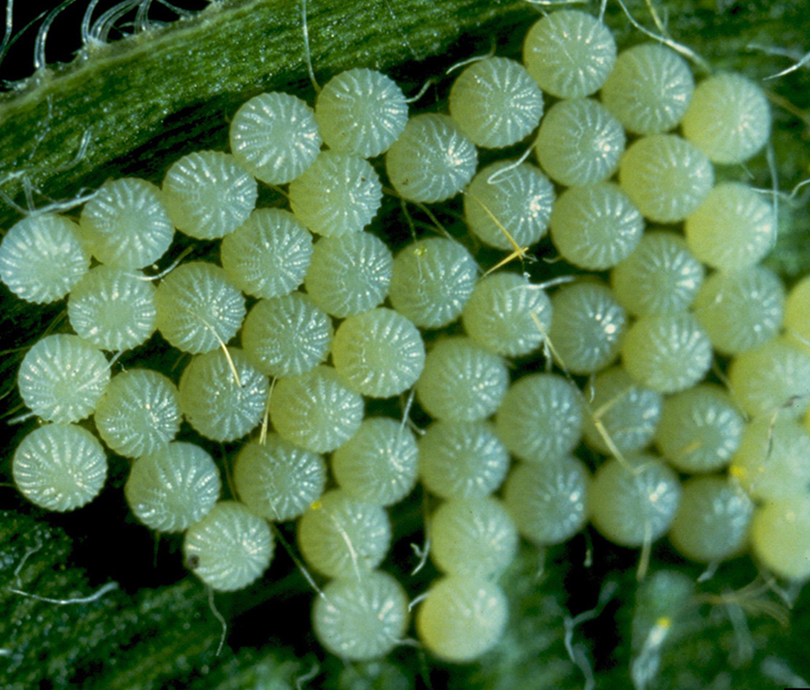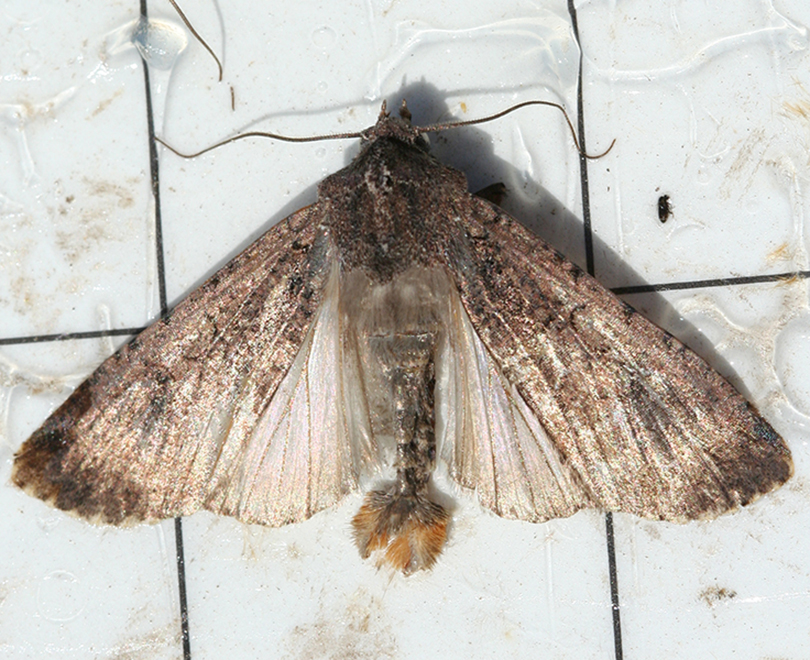Variegated Cutworm
Peridroma saucia
 Variegated cutworm larva feeding on hemp plant.
Variegated cutworm larva feeding on hemp plant.
 Variegated cutworm larva foliar feeding damage (on tobacco).
Variegated cutworm larva foliar feeding damage (on tobacco).
Hosts
- Field-grown hemp
- Nearly all vegetables
- Various grains, grasses, and weeds
Description
Larvae are dull gray to brown with 4 to 5 light spots on the middle of the back. They curl into a ‘C’ when disturbed. Adult moths have brown front wings with light-brown markings including circle- and kidney-shaped spots. The hind wings are dull white.
Life Cycle
Egg | Larva | Pupa | Adult
- 2 to 3 overlapping generations per year, starting in early spring, July, and late summer.
- Overwinter as pupae in the soil, larvae in protected areas, or possibly as adults.
- Some adults migrate from southerly locations each spring.
- Larvae pupate in the soil
Damaging Lifestage(s): Larva
Damage Symptoms
Unlike most cutworm larvae that cut stems at ground level, variegated cutworms climb plants and chew on leaves, buds, and flowers. In hemp, it primarily feeds on leaves, but could potentially damage hemp flowers. Larvae typically feed at night and return to the ground during the day to hide. They can often be found near the base of plants in protected areas.
Time for Concern
Spring through harvest.
When and Where to Scout
- Larvae can be seen as early as late January into April.
- Look for larvae hiding in the soil or leaf litter around plants during the day.
- Later in the season, monitor plants for foliage damage.
- Pheromone or black-light traps can be used to monitor adult moths.
Threat Level
Low.
Occurrence in Utah
In general, infestations on any crop are rare and sporadic in Utah.
Management
- Manage weeds along field edges.
- Approved insecticides are available.
When to Consider Treatment
When variegated cutworm larvae are present.
Look-alikes
Other larvae in the family Noctuidae and other caterpillars
Caterpillar Insecticides
| Utah-Registered Product | Active Ingredient(s) | Notes |
|---|---|---|
| Agree WG | Bacillus thuringiensis ssp. aizawa | |
| Aza-Direct Biological Insecticide | azadirachtin | |
| AzaGuard | azadirachtin | |
| AzaSol | azadirachtin | |
| Azatin O Biological Insecticide | azadirachtin | |
| Azatrol EC Insecticide | azadirachtin | |
| Azera Insecticide | azadirachtin | |
| BT Now | Bacillus thuringiensis ssp. kurstaki | Greenhouse use only. |
| Bug Buster-O Extinguish Ant Bait | pyrethrins | Greenhouse use only. |
| Deadzone | diatomaceous earth | |
| Deliver Biological Insecticide | Bacillus thuringiensis ssp. kurstaki | |
| DiPel DF Biological Insecticide | Bacillus thuringiensis ssp. kurstaki | |
| DiPel DF Biological Insecticide Dry Flowable |
Bacillus thuringiensis ssp. kurstaki | |
| DiPel PRO DF Biological Insecticide | Bacillus thuringiensis ssp. kurstaki | |
| Evergreen Crop Protection EC 60-6 | pyrethrins | |
| Ferti-Lome Dipel Dust Biological Insecticide (RTU) | Bacillus thuringiensis ssp. kurstaki | |
| Ferti-lome Fruit Tree Spray | pyrethrins | |
| Grandevo CG;WDG | Chromobacterium sub strain PRAA4-1 cells | |
| Javelin WG Biological Insecticide | Bacillus thuringiensis ssp. kurstaki | |
| Leprotec | Bacillus thuringiensis ssp. kurstaki | |
| Molt-X | azadirachtin | |
| Neemix 4.5 Insect Growth Regulator | azadirachtin | |
| Prizefighter | ammonium nonanoate | |
| Pycana | pyrethrins | Greenhouse use only. |
| Pyganic Crop Protection EC 1.4 II; 5.0 II | pyrethrins | |
| SPEAR-LEP | gs-omega/kappahxtx-hv1a | Supression only; combine with a Bt product for greater efficacy. |
| Tersus Insecticide | pyrethrins | |
| Thuricide N/G | Bacillus thuringiensis ssp. kurstaki | |
| Valent Professional Products DiPel Pro DF Biological Insecticide Dry Flowable |
Bacillus thuringiensis ssp. kurstaki | |
| Venerate CG | Burkholderia sp. strain A396 | |
| XenTari Biological Insecticide Dry Flowable | Bacillus thuringiensis ssp. aizawai |
Photo Credits
- Eggs - Frank Peairs, Colorado State University, Bugwood.org
- Adult - USU Extension IPM Program
- Pupa/Feeding - Whitney Cranshaw, Colorado State University, Bugwood.org
- Stem feeding - W.M. Hantsbarger, Bugwood.org
- Tobacco feeding - R.J. Reynolds Tobacco Company Slide Set, R.J. Reynolds Tobacco Company, Bugwood.org





